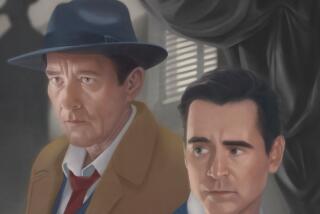Gumshoes and Crooks
Amid the continuing acclaim for “L.A. Confidential,” it’s a great opportunity to view some of its marvelous pedigree in the “Universal Noir” series that starts Friday at the Nuart.
The 14-film series, which played to its own acclaim last year in Boston and San Francisco, features the usual suspects from Universal’s library (including several hard-boiled Paramount classics)--with a few oddities just to be risky.
Actually, this is the first Universal retro series in more than a decade (with more to come), and the studio has struck new 35mm prints from the original negatives for the occasion. Happily, most of the films look dazzling, reminding us just how powerful and seductive the nightmarish underworld can be on the big screen in black and white.
“Universal Noir” kicks off the weekend with the high and low pairing of “Touch of Evil” and the original “Cape Fear,” two cult favorites that couldn’t be more disparate in their aims and achievements yet still part of noir’s prevailing cynicism.
Leave it to Orson Welles, of course, to transform such pulp about police corruption into a baroque Shakespearean tragedy about love, loss and betrayal. Welles admirers and noir fans alike adore “Touch of Evil” for its bizarre audacity (Charlton Heston as a Mexican cop! Marlene Dietrich as a Gypsy fortuneteller!). But it’s an acquired taste. The version being screened is the longer studio cut, which Welles disliked. Interestingly, there is currently an attempt to reconstruct Welles’ original cut from 1957, including, among other things, the bravura opening tracking shot leading up to the bomb explosion without the credits.
Although “Cape Fear” has been screened often in recent years, its stature will undoubtedly rise as we continue reevaluating Robert Mitchum’s career. His swaggeringly sadistic Max Cady is one of the best psychopaths in the noir canon, and the main reason to see this pedestrian 1962 film (along with Bernard Herrmann’s brash score). Mitchum’s carnal incarnation of evil has such a delightfully lurid fascination.
Why this continuing fascination with noir, anyway? According to Eddie Muller, author of “Dark City: the Lost World of Film Noir,” a lively and informed look at noir’s cultural mystique (due in early March from St. Martin’s/Griffin), it’s because the cynicism was so prescient.
“The acceptance of corruption was done with such style and elan,” Muller says. “The system isn’t going to work to our benefit, but we’re going out in style is the essential ingredient. It’s a wake-up call--there’s a lot more corruption than we’re willing to admit. It has a hold on this generation because of our current cultural cynicism.”
You could say “The Glass Key” (screening Jan. 11) is a model of corruption, having influenced everything from “Yojimbo” to “Miller’s Crossing.” The best of the natty Alan Ladd/Veronica Lake pairings, this 1942 Dashiell Hammett adaptation is renowned for its intricate deceit and daring brutality. Who, for instance, can ever forget the sexual delight William Bendix derives from beating Ladd?
“The Killers” (screening Sunday) possesses a different kind of intricacy. This 1946 heist film, featuring newcomer Burt Lancaster at his softest and a sultry Ava Gardner, is the “Citizen Kane” of noir, with its overlapping flashbacks and existential mystery. Robert Siodmak, Universal’s quintessential noir director, sets the tone immediately with the arrival of the two killers (William Conrad and Charles McGraw), marking the territory between life and death with a deft interplay of light and shadow.
Few could match Siodmak’s Germanic atmospherics, which are additionally on display in “Phantom Lady” (also screening Sunday) and “Criss Cross,” another caper starring Lancaster (screening Jan. 9 and 10). “Phantom Lady,” from 1944, is noteworthy for being a Cornell Woolrich adaptation--and the combination of Siodmak and Woolrich is certifiably combustible. Certainly there’s the famous after-midnight jam session, where Elisha Cook orgasmically drums up a storm for Ella Raines. But there are other menacing trappings as well (like Raines’ creepy pursuit of a bartender), not to mention Franchot Tone’s ridiculously crazed artist.
Speaking of crazed artists, the usually creepy Dan Duryea turns up as a sympathetic loser in another Woolrich adaptation, “Black Angel” (screening Jan. 8). This is a rarity worth waiting for. Duryea is an alcoholic honky-tonk piano player who teams up with torch singer June Vincent in trying to clear her dopey husband of murdering Duryea’s ex-wife. Gripping and melancholy, this 1946 mystery epitomizes the broken dreams mentality of noir.
If there’s an orphan in the bunch, it’s Fritz Lang’s “You and Me” (screening Monday). This strange 1938 Runyon-esque fable--with music by Kurt Weill, no less--unmistakably bears the director’s fatalistic touch. A charming George Raft is part of an ex-con program in Harry Carey’s department store. He marries sweet Sylvia Sydney, who tries to hide her own mysterious past, tormenting him back to his old gang.
The highlight is a musical sequence, “Stick With the Mob,” in which the gang recounts its prison stint and unceasing loyalty, shot in a wild, hallucinatory style. Yet Sidney’s climactic “Crime Doesn’t Pay” blackboard lesson is pure Capra.
The series’ final rarity is “Blast of Silence,” an ersatz noir from 1961 shot on location throughout New York (screening Jan. 8), with an inspired voice-over by the gravelly Lionel Stander. The auteurist creation of Allen Baron, “Blast of Silence” is about a stoic hit man who tries to regain his humanity while setting up his latest target in the haunts of his past. Most of it is amateurish, but the sad inevitability of the loner’s fate somehow makes it worthwhile.
Then there’s “Double Indemnity” (screening Jan. 9 and 10), which continues to hold up as the consummate noir. For this 1944 masterpiece, we have Billy Wilder to thank. He craftily wraps a bleak romanticism around a compelling love triangle. For all of Barbara Stanwyck’s erotic black-widowing and Fred MacMurray’s tough guy posturing, it’s Edward G. Robinson’s wise-guy arias that really elevate it. There’s probably no better sign of intimacy in noir than Robinson and MacMurray’s cigar-lighting ritual.
Enjoy it all, because that style of filmmaking is not coming back, despite “L.A. Confidential’s” success.
BE THERE
“Universal Noir” at the Nuart, 11272 Santa Monica Blvd., West Los Angeles, (310) 478-6379.
More to Read
Only good movies
Get the Indie Focus newsletter, Mark Olsen's weekly guide to the world of cinema.
You may occasionally receive promotional content from the Los Angeles Times.










